Recording Considerations
Learn about important acoustic concepts that need to be considered when in any recording environment.
- Proximity Effect
- Inverse Square Law
- Critical Distance
- 3 to 1 Rule
- Room Acoustics
- Slap Echo
- Standing Waves
- Comb Filtering
Proximity Effect
The proximity effect is the exaggeration of low-frequency sound in a uni-directional microphone when it is near the sound source (less than 30cm). This bass increase is directly linked to the inverse square law.
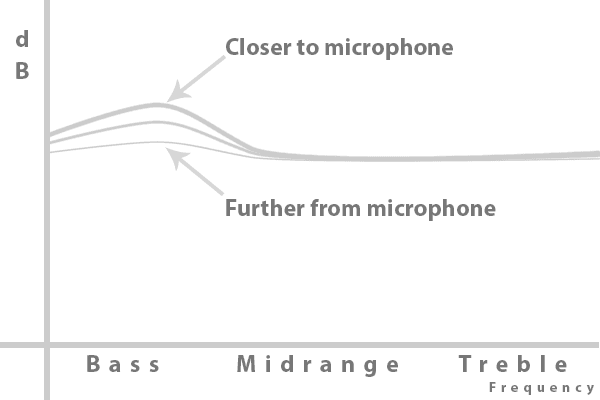
Generally, the proximity effect is not too much of a problem and can actually be beneficial in some cases, such as it can help singers with high or thin voices by filling out the sound.
If the proximity effect does become a problem, some microphones have a low-frequency roll-off filter switch that can be used to compensate for the increased bass. If the microphone has not got a low-frequency roll-off filter switch, it is possible to use a high pass filter to reduce the lower end.
Inverse Square Law
An important property of direct sound is that it becomes weaker as it travels away from the sound source. The change is determined by the inverse square law.
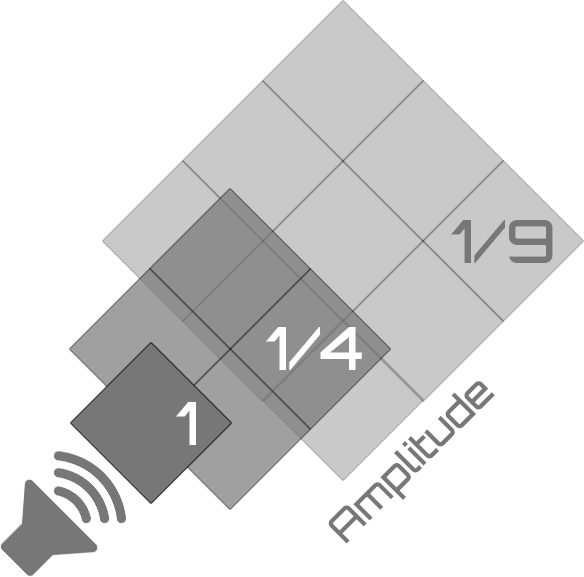
The inverse square law states that direct sound wave levels increase proportionally to the square of the change in distance. So, for every doubling of the distance from the sound source in free space, the sound intensity will diminish by 6 decibels. Likewise, if the distance is halved there is an increase of 6 decibels.
Critical Distance
The critical distance is the distance between the microphone and the sound source at which the level of room reverberation (ambient sound) is equal to the level of the direct sound.
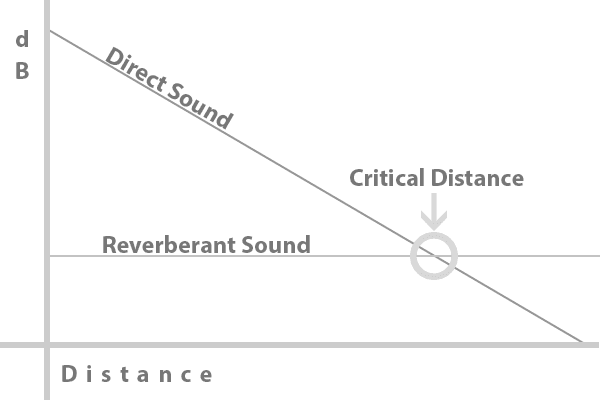
Placing the microphone farther away than this critical distance may lead to a muddy sounding recording because the room sound will be predominant, particularly in rooms with poor or no acoustic design.
Critical distance may be estimated by listening to the sound source at close range, then moving it back until the sound level no longer decreases but seems constant.
3 to 1 Rule
When multiple microphones are used, the distance between them should be three times the distance from each microphone to its intended sound source. This is to prevent interferences, phase cancellation and the unpleasant hollow effect called comb filtering.
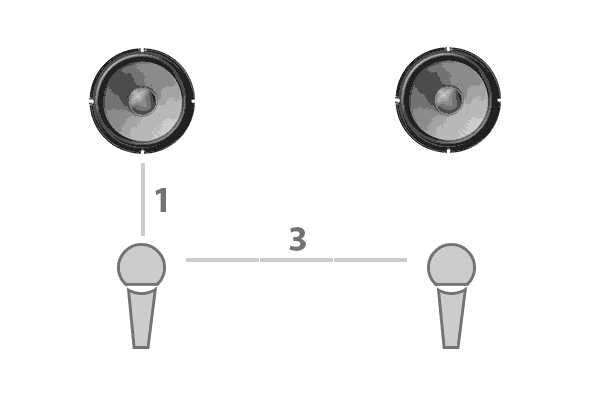
The 3 to 1 rule works on the basis of using distance to reduce the pickup of one sound source in the microphone intended for another source. Because the sound picked up by the more distant microphone is at least 12dB less than the sound picked up by the closer one, interference problems are prevented.
It should be noted that microphones should also be kept at least one and a half times as far from reflective surfaces as from its intended sound source. Again, this is to eliminate interference, phase cancellation and comb filtering.
Room Acoustics
When recording, it is important that the room acoustics do not alter the quality of the sound in a negative way.
There are two ways to enforce this; soundproofing and acoustic treatment.
Soundproofing is any mechanism used to reduce the conduction of sound through a barrier or into a soundproofed chamber. It affects sound in two ways; sound absorption and sound reduction.
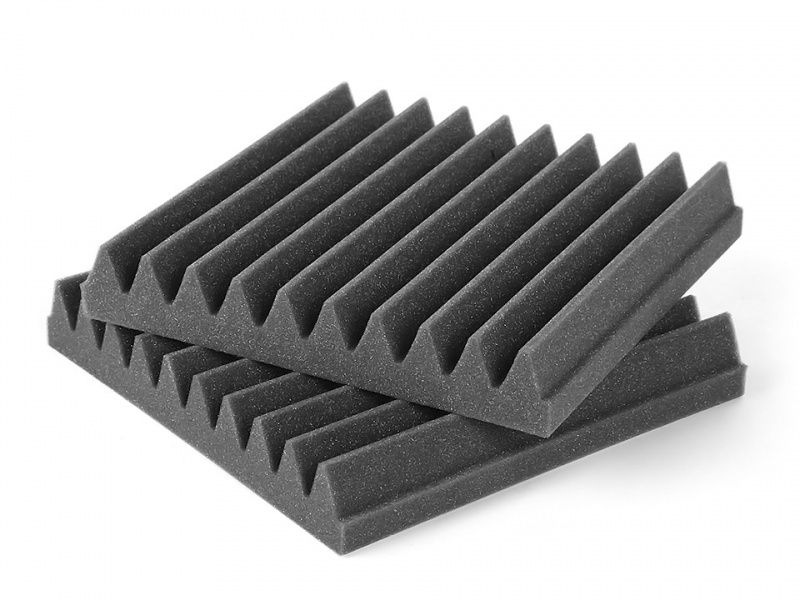
- Sound absorption operates by transforming the sound wave
- Sound reduction simply blocks the passage of sound waves through the use of mass and space.
Acoustic treatment is more concerned in dealing with the acoustic quality of the room from a listener's point of view.
The most problematic sound behaviour is reflection, as it is responsible for three different types of unwanted audible phenomena
- slap echo
- standing waves
- comb filtering
Slap Echo
Slap echo is the occurrence of sound reflecting back and forth off two parallel hard surfaces. The sound reverberates repeatedly until all the energy eventually dissipates away.
Slap echo interferes with sound by adding harshness to the upper mid-range and treble by destroying the delicate phase relationships which help to establish an accurate sound. The result can be described as being zingy.
Slap echo is most common in bedroom home studios which have had little or no acoustic treatment. Hard, reflective, parallel walls encourage the presence of slap echo.
It is possible to control slap echo with absorptive materials such as cork boards, drapes and carpet. In many home studio environments, furnishings such as sofas are the primary structural components to help control slap echo. Unfortunately, their effectiveness is unpredictable and not recommended.
Standing Waves
Standing waves cause the unnatural boosting or cutting of certain frequencies. They are typically prominent in the bass range and found at certain discreet locations in the room.
Standing waves are formed when two waves, travelling in opposite directions with identical frequency and amplitude, collide. Unlike travelling waves, standing waves appear to vibrate in place. That is, the wave peaks alternate from positive to negative in place but do not move forwards or backwards. Each peak terminates with a point of zero displacement on both sides.
Standing waves are difficult to control because they tend to occur at a lower frequency, whose wavelength is long enough to be ineffectively controlled by absorbent materials. Adjusting the speaker position can have an effect on the production of standing waves.
In general, placement of the speaker in a corner will excite the maximum number of standing waves in a room and is to be avoided for most full-range loudspeaker systems.
Comb Filtering
Comb filtering occurs when a sound is directed toward a microphone or listener at a distance. The first sound to reach the microphone will be the direct sound, followed by delayed reflected sound. Because the reflected sound lags in time and phase relative to the direct sound, there will be a cancellation at certain frequencies where the two are 180 degrees out of phase and increase at other frequencies where the direct and the reflected sounds arrive in phase.
Because comb filtering is a function of wavelength, the comb filter effect will notch out portions of the audio spectrum at regularly spaced intervals.
The subjective effect of comb filter is an added roughness to the sound and a reduction of harmonic richness.
The sidewall reflections which cause the comb filter effects are best controlled by careful speaker placement and by the placement of diffusers to the part of the wall where the reflection occurs.
It's worth remembering that comb filtering can also be present in stereo microphone technique.
 Teach Me Audio
Teach Me Audio